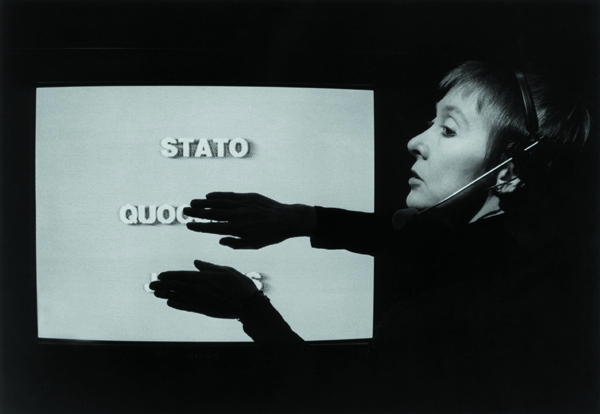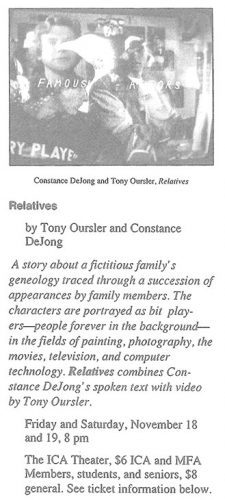
Constance DeJong in original 1989 performance of Relatives at the Kitchen (photo © Paula Court / courtesy of the artist and Bureau)
The Kitchen
512 West 19th St. between Tenth & Eleventh Aves.
Friday, March 23, and Saturday, March 24, $15-$20, 8:00
212-255-5793 ext11
thekitchen.org
Nearly thirty years ago, writer and performance artist Constance DeJong and multimedia artist Tony Oursler performed Relatives at the Kitchen, a duet between a human being and a television set that explored questions of family and genealogy through spoken and visual text and various forms of technology. The work, which was commissioned by the ICA Boston, incorporated aspects of art, language, video games, and cinema in telling the story of the fictional McCloud family in words and images. DeJong and Oursler — the two also collaborated with Stephen Vitiello for the 1995 online project Fantastic Prayers, and DeJong portrayed Madam X in Oursler’s recent 5-D Imponderable film and installation at MoMA — are bringing the piece back for two special performances this weekend, Friday and Saturday night at the Kitchen, where it played in 1989, a few years after the video revolution spurred by the success of MTV, so it should be fascinating to see how it has aged in the iPhone generation. “After seeing me perform, Tony invited me to see his work and, almost immediately, he suggested we collaborate,” the Cleveland-born DeJong tells Rachel Valinsky in a new interview on the Kitchen blog. “I was using prerecorded audio in performance and wanted to introduce video in my live work. Tony was like no one. His video sensibility was unique, partly a generational difference: he was twenty-six and had made, in single-channel videos, a very compelling comingling of DIY methods (drawing, paint, cardboard, etc.) and time-based technology. That early Oursler aesthetic is in Relatives.”

Meanwhile, New York City native Oursler explains, “When constructing this work together we played with the idea of a dialogue between live and prerecorded characters and the duality and mutability of image and text. Relatives attempts to register these narrative relationships to a cast of bit players strewn across a vast history of mediums and technologies. As always, our memories have migrated in various forms to oil paintings, home movies and videos, snapshots, and social media, only to be reshuffled by successive generations. DeJong takes a circuitous route through this terrain, pointing out an unlikely family history while always returning to the dilemma of the relationship between the individual and the screen.” At one point in the show, DeJong, in character, looking at images on a small TV, says, “The emotive value of colors, of symbolic animals and plants, I am compelled to arrange my elements much as wind arranges leaves, as a magnet attracts from a pile of things. The number eleven, in this figure which attracts me like no other, my identity, Georgia McCloud, is revealed and yet concealed.” That duology is at the heart of Relatives, which is organized at the Kitchen by Matthew Lyons. “We were working in the dark in a way,” DeJong adds. “Neither of us had produced a performance like this, made of concurrent language and video.”